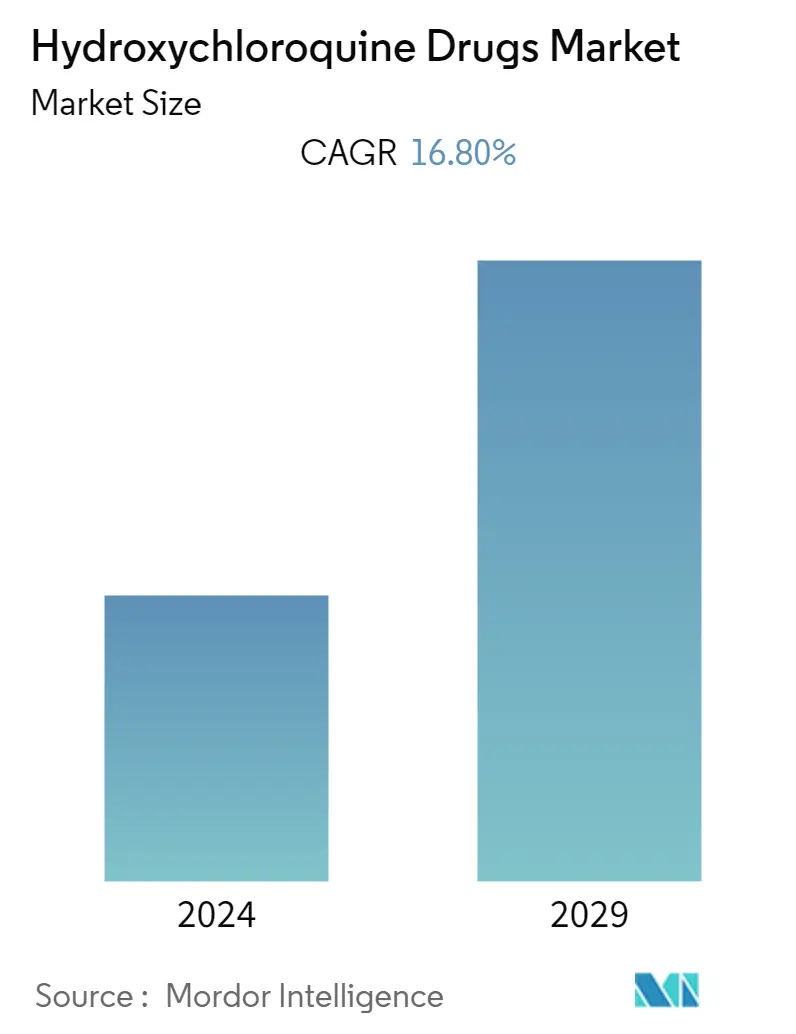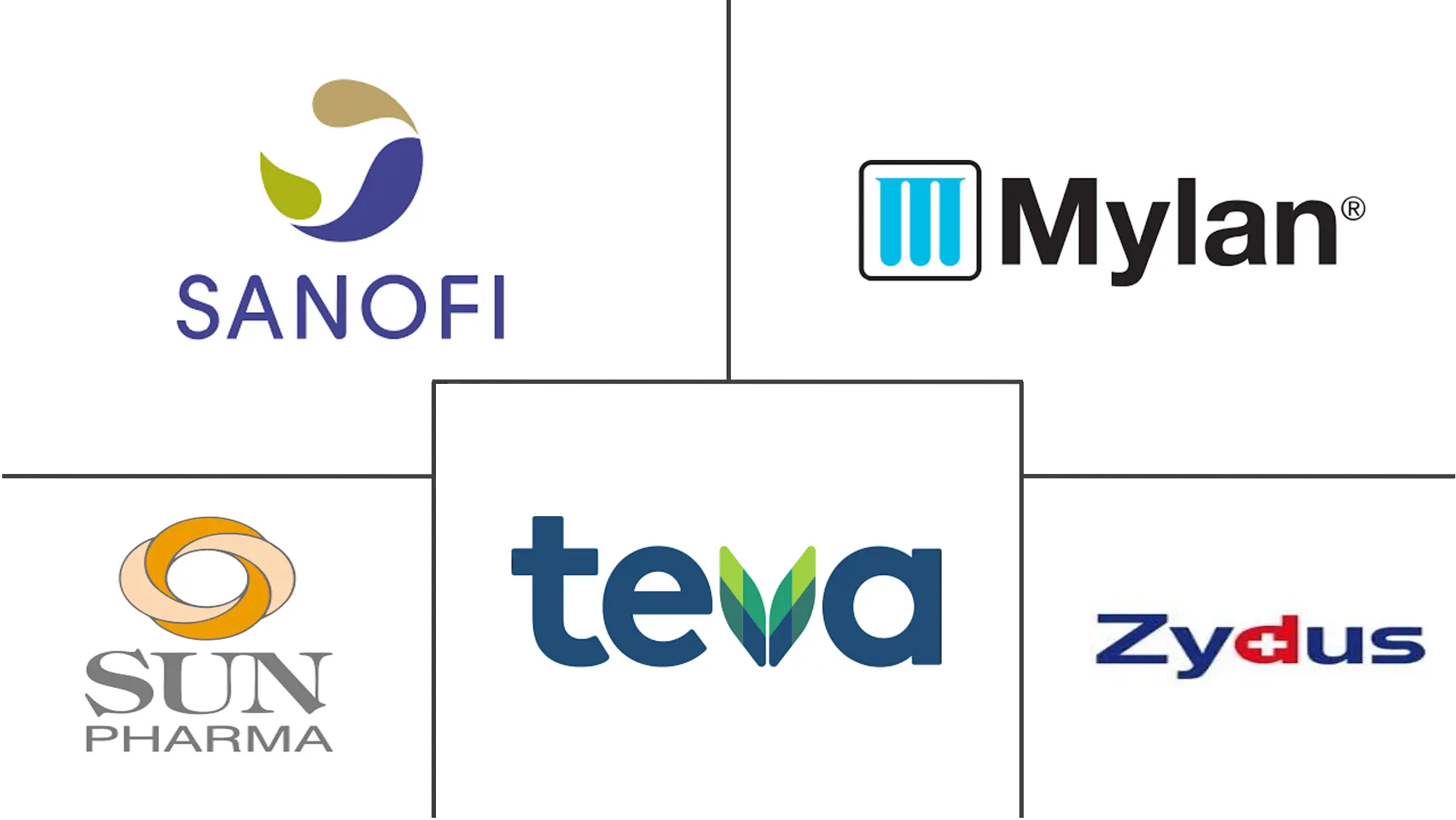
| Study Period | 2019 - 2029 |
| Base Year For Estimation | 2023 |
| Forecast Data Period | 2024 - 2029 |
| Historical Data Period | 2019 - 2022 |
| CAGR | 16.80 % |
| Fastest Growing Market | Asia Pacific |
| Largest Market | North America |
Major Players
*Disclaimer: Major Players sorted in no particular order |
Hydroxychloroquine Drugs Market Analysis
The global hydroxychloroquine drugs market studied was anticipated to register a CAGR of nearly 16.8% during the forecast period. Hydroxychloroquine is a safer derivative of chloroquine. Hydroxychloroquine is an immunosuppressive and anti-parasite drug indicated for the treatment or prevention of malaria, although the drug is ineffective for chloroquine-resistant malaria. Hydroxychloroquine is also recommended for autoimmune diseases such as systemic and discoid lupus erythematosus, and rheumatoid arthritis (acute and severe) when other medications fail to work or cannot be used. Broad-spectrum hydroxychloroquine drugs can be used to treat a range of viruses. According to China's Ministry of Science and Technology, hydroxychloroquine is one of the drugs which demonstrated encouraging profile for blocking coronavirus in early clinical trials.
Recently, hydroxychloroquine has attracted attention due to its effectiveness in treating patients with coronavirus disease (COVID 19). Reports from China demonstrated chloroquine could possibly inhibit SARS-CoV-2 in vitro. The drug showed high efficacy in treating the patients with coronavirus disease (COVID 19). Hydroxychloroquine is expected to be a promising potential treatment for the coronavirus disease (COVID 19). The US Food and Drug Administration (FDA) designated hydroxychloroquine for emergency use for treating coronavirus disease (COVID 19).
Increasing demand for novel hydroxychloroquine and rising penetration of generic drugs are estimated to provide a significant boost to the market. For instance, in March 2020, Novartis International AG started the shipping of 30 million doses of hydroxychloroquine tablets to the US Department of Health and Human Services (HHS) for controlled clinical studies to evaluate the effectiveness of hydroxychloroquine in people who have tested positive for coronavirus disease (COVID 19). In addition, increasing product approval is poised to have strong market penetration due to the presence of increased government funding.
Growing patient awareness regarding COVID-19 and the influx of new generics in the global arena are projected to accelerate the adoption of hydroxychloroquine drugs. As per the Johns Hopkins University, as of 15th April 2020, approximately 609,516 people suffered from COVID-19 in the US alone. Increasing awareness regarding disease remittance therapies, rising clinical trials to evaluate the effectiveness of hydroxychloroquine in the treatment of COVID-19 are estimated to promote revenue growth. However, poor healthcare accessibility in low-income countries may restrain the growth of the market.
Hydroxychloroquine Drugs Industry Segmentation
This report forecasts revenue growth at global, regional, and country levels and provides an analysis of the latest industry trends in each of the sub-segments from 2017 to 2025. For the purpose of this study, Mordor Intelligence has segmented the global hydroxychloroquine drugs market report on the basis of disease type, distribution channel, and region.
| Coronavirus Disease (COVID-19) |
| Malaria |
| Lupus Erythematosus |
| Rheumatoid Arthritis |
| Online Pharmacy |
| Hospital Pharmacy |
| Retail Pharmacy |
| North America | United States |
| Canada | |
| Mexico | |
| Europe | Germany |
| United Kingdom | |
| France | |
| Italy | |
| Spain | |
| Rest of Europe | |
| Asia-Pacific | China |
| Japan | |
| India | |
| Australia | |
| South Korea | |
| Rest of Asia-Pacific | |
| Middle-East and Africa | GCC |
| South Africa | |
| Rest of Middle-East and Africa | |
| South America | Brazil |
| Argentina | |
| Rest of South America |
Hydroxychloroquine Drugs Market Size Summary
The hydroxychloroquine drugs market is poised for significant growth, driven by its applications in treating malaria, autoimmune diseases, and its recent spotlight due to its potential efficacy against COVID-19. As a safer derivative of chloroquine, hydroxychloroquine serves as an immunosuppressive and anti-parasitic agent, with its use extending to conditions like systemic and discoid lupus erythematosus and rheumatoid arthritis, particularly when other treatments are ineffective. The drug gained attention during the COVID-19 pandemic, with early clinical trials suggesting its ability to inhibit the coronavirus, leading to emergency use authorization by the US FDA. The market is further bolstered by increasing demand for novel hydroxychloroquine formulations and the rising penetration of generic drugs, supported by government funding and product approvals.
The market landscape is characterized by a strong presence of generic drug manufacturers, with companies like DR. REDDY'S LABORATORIES, Laurus Labs, and Sun Pharmaceutical Industries playing pivotal roles. North America leads in market growth due to high healthcare spending and awareness, while the Asia-Pacific region is expected to experience the fastest growth, driven by increasing healthcare investments and the presence of key manufacturers. The rheumatoid arthritis segment is anticipated to dominate the market, supported by the rising prevalence of the condition and the availability of cost-effective generic drugs. The introduction of generic versions and a robust clinical pipeline are expected to intensify competition, with companies expanding production capacities to meet the growing demand for hydroxychloroquine-based treatments.
Hydroxychloroquine Drugs Market Size - Table of Contents
1. MARKET DYNAMICS
- 1.1 Market Overview
-
1.2 Market Drivers
- 1.2.1 Disease Outbreaks Such As Coronavirus Disease (COVID 19)
- 1.2.2 High prevalence of Malaria and Rheumatoid Arthritis
- 1.2.3 Increasing Product Launches and Approvals
- 1.2.4 Expanding Application of Hydroxychloroquine in Various Therapeutic Conditions
-
1.3 Market Restraints
- 1.3.1 Global Shortage of Hydroxychloroquine
- 1.3.2 Poor Healthcare Accessibility in Low Income Countries
-
1.4 Porter's Five Forces Analysis
- 1.4.1 Threat of New Entrants
- 1.4.2 Bargaining Power of Buyers/Consumers
- 1.4.3 Bargaining Power of Suppliers
- 1.4.4 Threat of Substitute Products
- 1.4.5 Intensity of Competitive Rivalry
2. MARKET SEGMENTATION
-
2.1 By Application
- 2.1.1 Coronavirus Disease (COVID-19)
- 2.1.2 Malaria
- 2.1.3 Lupus Erythematosus
- 2.1.4 Rheumatoid Arthritis
-
2.2 By distribution Channel
- 2.2.1 Online Pharmacy
- 2.2.2 Hospital Pharmacy
- 2.2.3 Retail Pharmacy
-
2.3 Geography
- 2.3.1 North America
- 2.3.1.1 United States
- 2.3.1.2 Canada
- 2.3.1.3 Mexico
- 2.3.2 Europe
- 2.3.2.1 Germany
- 2.3.2.2 United Kingdom
- 2.3.2.3 France
- 2.3.2.4 Italy
- 2.3.2.5 Spain
- 2.3.2.6 Rest of Europe
- 2.3.3 Asia-Pacific
- 2.3.3.1 China
- 2.3.3.2 Japan
- 2.3.3.3 India
- 2.3.3.4 Australia
- 2.3.3.5 South Korea
- 2.3.3.6 Rest of Asia-Pacific
- 2.3.4 Middle-East and Africa
- 2.3.4.1 GCC
- 2.3.4.2 South Africa
- 2.3.4.3 Rest of Middle-East and Africa
- 2.3.5 South America
- 2.3.5.1 Brazil
- 2.3.5.2 Argentina
- 2.3.5.3 Rest of South America
Hydroxychloroquine Drugs Market Research FAQs
What is the current Hydroxychloroquine Drugs Market size?
The Hydroxychloroquine Drugs Market is projected to register a CAGR of 16.8% during the forecast period (2025-2030)
Who are the key players in Hydroxychloroquine Drugs Market?
Sanofi S.A, Sun Pharmaceutical Industries Ltd., Mylan N.V, Teva Pharmaceuticals USA, Inc and Zydus Pharmaceuticals are the major companies operating in the Hydroxychloroquine Drugs Market.


